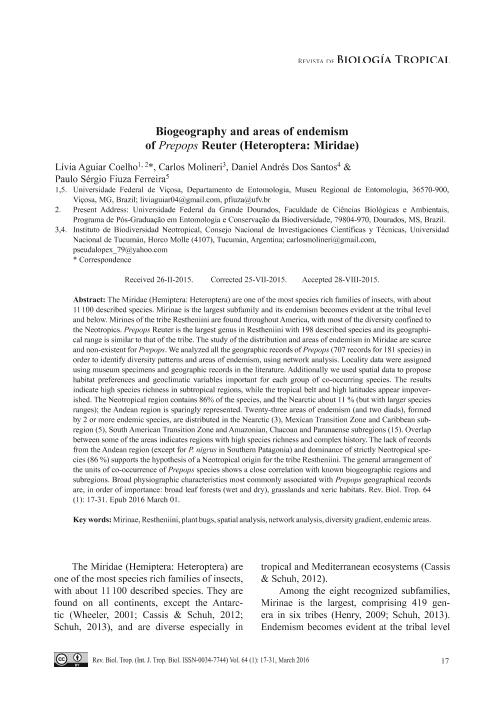Artículo
Biogeography and areas of endemism of Prepops Reuter (Heteroptera: Miridae)
Título:
Biogeografía y áreas de endemismo de Prepops Reuter (Heteroptera: Miridae)
Fecha de publicación:
03/2016
Editorial:
Revista de Biología Tropical
Revista:
Revista de Biología Tropical
ISSN:
2215-2075
Idioma:
Inglés
Tipo de recurso:
Artículo publicado
Clasificación temática:
Resumen
The Miridae (Hemiptera: Heteroptera) are one of the most species rich families of insects, with about 11 100 described species. Mirinae is the largest subfamily and its endemism becomes evident at the tribal level and below. Mirines of the tribe Restheniini are found throughout America, with most of the diversity confined to the Neotropics. Prepops Reuter is the largest genus in Restheniini with 198 described species and its geographical range is similar to that of the tribe. The study of the distribution and areas of endemism in Miridae are scarce and non-existent for Prepops. We analyzed all the geographic records of Prepops (707 records for 181 species) in order to identify diversity patterns and areas of endemism, using network analysis. Locality data were assigned using museum specimens and geographic records in the literature. Additionally we used spatial data to propose habitat preferences and geoclimatic variables important for each group of co-occurring species. The results indicate high species richness in subtropical regions, while the tropical belt and high latitudes appear impoverished. The Neotropical region contains 86% of the species, and the Nearctic about 11 % (but with larger species ranges); the Andean region is sparingly represented. Twenty-three areas of endemism (and two diads), formed by 2 or more endemic species, are distributed in the Nearctic (3), Mexican Transition Zone and Caribbean subregion (5), South American Transition Zone and Amazonian, Chacoan and Paranaense subregions (15). Overlap between some of the areas indicates regions with high species richness and complex history. The lack of records from the Andean region (except for P. nigrus in Southern Patagonia) and dominance of strictly Neotropical species (86 %) supports the hypothesis of a Neotropical origin for the tribe Restheniini. The general arrangement of the units of co-occurrence of Prepops species shows a close correlation with known biogeographic regions and subregions. Broad physiographic characteristics most commonly associated with Prepops geographical records are, in order of importance: broad leaf forests (wet and dry), grasslands and xeric habitats.
Archivos asociados
Licencia
Identificadores
Colecciones
Articulos(IBN)
Articulos de INSTITUTO DE BIODIVERSIDAD NEOTROPICAL
Articulos de INSTITUTO DE BIODIVERSIDAD NEOTROPICAL
Citación
Aguiar Coelho, Livia; Molineri, Carlos; Dos Santos, Daniel Andrés; Fiuza Ferreira, Paulo Sergio; Biogeography and areas of endemism of Prepops Reuter (Heteroptera: Miridae); Revista de Biología Tropical; Revista de Biología Tropical; 64; 1; 3-2016; 17-31
Compartir
Altmétricas




